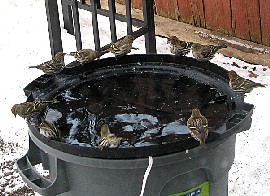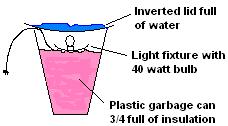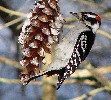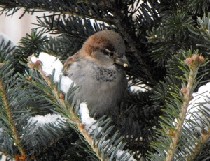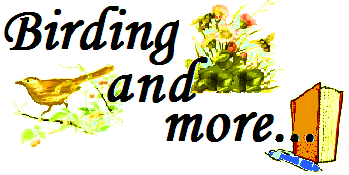 Newsletter
Newsletter
2010
/ Issue 1
IN THIS ISSUE: HOW TO BUILD AN INEXPENSIVE WINTER BIRDBATH
HOW TO BUILD A WINTER BIRDBATH
You're
probably wondering why birds would ever need a birdbath in the winter.
I wondered the same thing - especially in places like Ontario where the
winters are super cold. But it's actually very important for birds
during very cold weather. First of all, birds need water for drinking
and they are very happy to have a water supply at those times when most
of their water supplies have been frozen. Also, bathing is essential
for birds to keep their feathers in good condition. Having clean
feathers makes preening easier. The oil (from the bird's preen gland)
is spread during preening, which keeps the bird waterproof and helps to
trap a layer of air under the feathers, which keeps them warm.
See how popular it is:
Instructions:
1. Fill a large plastic garbage can ¾ full with non-flammable insulation
2. Place a light fixture with a 40watt incandescent light bulb on top
of the insulation
3. Turn the lid upside down and place it on top (see illustration below)
4. Put water in the lid and plug in the light
*** Empty the lid and unplug the light each evening, and refill with fresh water each morning. The birds will love you!!
What's New at http://www.birdingandmore.com/
Jan 2. New picture (of a Cooper's Hawk) added to the 'Backyard Birds' gallery
Jan
3.
Added a new page: "Places to Bird"
Jan
6.
New blog entry "January Doldrums"
Jan 9. New blog entry "A Murder of Crows" (read this blog if you want to find out what a poetic collective noun is) :)
Picture of the week
From the "Wild Birds" gallery of our website
This space is
for your photos, stories, and/or comments.
Send anything
you'd like to share with us to: newsletter@birdingandmore.com
WORDS TO THE
WISE
Avoid low-cost mixed birdseed
It
is not a bargain. It contains lots of filler (like Milo) which the
birds wont eat. If you have to have mixed seed, then buy a premium mix
prepared by a specialty store. However, the best approach is to buy
specific seed that you know the birds will relish.
Heres a list of a few we like:
Black Oil sunflower seeds: Great for almost all birds.
Nyger seed: Loved by Goldfinches, House Finches, Siskins, Redpolls - we've even seen Juncos, Sparrows, and Chickadees eating at tube feeders.
Safflower seeds: A favourite of House Finches, Cardinals, Chickadees, and Mourning Doves. The great thing about safflower is that squirrels won't eat it, and neither will Grackles or Starlings.
White millet: An inexpensive seed that is great for ground birds like Juncos, Sparrows, Doves, and even Redpolls.
Peanuts:
A
Blue Jay favourite when they're in the shell, and a big hit with
Woodpeckers, Nuthatches, and Chickadees out of the shell.
It might be too late for this year but tuck this idea away in the back of your mind for next year - and if your city hasn't collected the Christmas trees left at the curb for pickup, maybe it isn't to late!!
Evergreen trees are an important resource for
birds - they offer shelter from the wind and the snow as well as
protection from predators. If your property is lacking in evergreens,
either put out your discarded Christmas tree or drag one home that was
left by the curb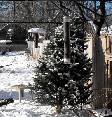
It was an instant delight to the juncos and sparrows, especially after throwing a couple of handfuls of white millet into the branches!
If you liked our newsletter
please pass it along to your friends and family.
Subsciptions are free! Just send an
email to: newsletter@birdingandmore.com
If you wish to cancel your subscription send an email to unsubscribe@birdingandmore.com
